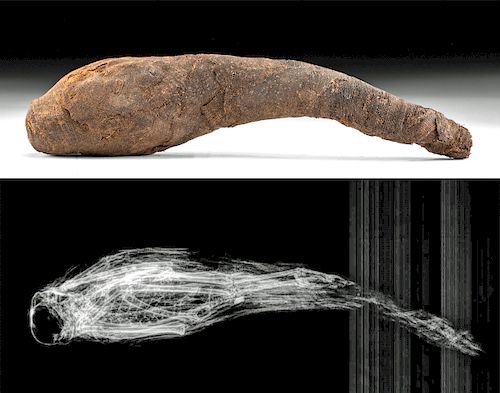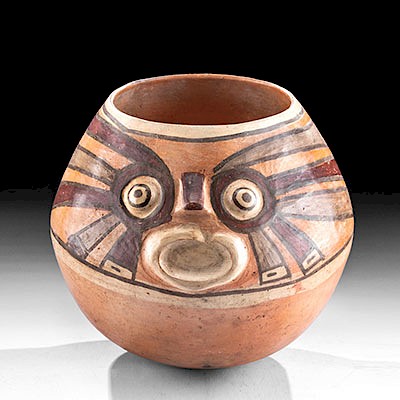Egyptian Late Period Mummified Young Baboon w/ x-Ray
Lot 3
About Seller
Artemis Gallery
686 S Taylor Ave, Ste 106
Louisville, CO 80027
United States
Selling antiquities, ancient and ethnographic art online since 1993, Artemis Gallery specializes in Classical Antiquities (Egyptian, Greek, Roman, Near Eastern), Asian, Pre-Columbian, African / Tribal / Oceanographic art. Our extensive inventory includes pottery, stone, metal, wood, glass and textil...Read more
Categories
Estimate:
$3,000 - $4,500
Absentee vs Live bid
Two ways to bid:
- Leave a max absentee bid and the platform will bid on your behalf up to your maximum bid during the live auction.
- Bid live during the auction and your bids will be submitted real-time to the auctioneer.
Bid Increments
| Price | Bid Increment |
|---|---|
| $0 | $25 |
| $300 | $50 |
| $1,000 | $100 |
| $2,000 | $250 |
| $5,000 | $500 |
| $10,000 | $1,000 |
| $20,000 | $2,500 |
| $50,000 | $5,000 |
| $100,000 | $10,000 |
| $200,000 | $20,000 |
About Auction
By Artemis Gallery
Dec 5, 2019
Set Reminder
2019-12-05 10:00:00
2019-12-05 10:00:00
America/New_York
Bidsquare
Bidsquare : Ancient / Ethnographic - Holiday Edition
https://www.bidsquare.com/auctions/artemis-gallery/ancient-ethnographic---holiday-edition-4710
What to give this holiday season? Ancient & Ethnographic Art of course! Our special Holiday auction features hundreds of unique finds from all over the world. Artemis Gallery info@artemisgallery.com
What to give this holiday season? Ancient & Ethnographic Art of course! Our special Holiday auction features hundreds of unique finds from all over the world. Artemis Gallery info@artemisgallery.com
- Lot Description
Egypt, Late Dynastic to Ptolemaic period, ca. 664 to 30 BCE. A wondrous linen-wrapped mummified baboon that was of a young age when it was sacrificed. The body is tightly bundled so that the rough outline of the skull and tail are displayed, and the profile of the humerus and radius/ulna of one arm are visible. Mummified animals like this example were intended as offerings to certain deities for protection or blessings as the ancient Egyptians were known for breeding and capturing animals specifically for this purpose. Given the Egyptians belief that baboons held a higher intelligence than most creatures, they were regularly sacrificed to Thoth, the god of mathematics, reading, and other intellectual pursuits. However, since baboons were believed to house the souls of the dead, mummified baboons were also offered to Babi (also Baba), a baboon-form deity whom resides in the underworld. Size: 10.375" L x 2.5" W (26.4 cm x 6.4 cm)
According to Egyptologists Erik Hornung and Betsy M. Bryan, "As primeval animals, baboons and green monkeys were prominent parts of the Egyptian cosmogony. The earliest gods are sometimes depicted with baboon heads. The baboon became an aspect of the sun god, Re . . . And of the moon god, Thoth-Khonsu. Thoth (Djehuty in ancient Egyptian) was the god of writing and knowledge, who was depicted in the form of two animals: the baboon (Papio cynocephalus) and the sacred Ibis (Threskiornis aethiopicus). In his baboon form Thoth was closely associated with the baboon god, Hedj-wer (the great white one) of the Early Dynastic period. By the end of the Old Kingdom (2686 - 2181 BCE) he was usually portrayed as an ibis-headed man, holding a scribal palette and pen or a notched palm leaf, performing some kind of act of recording or calculation." (Hornung, Erik and Betsy M. Bryan, eds. "The Quest for Immortality: Treasures of Ancient Egypt." National Gallery of Art, Washington, 2002, p. 200)
For an example of a mummified adult baboon in an upright seated position, please see The British Museum, museum number EA35857.
Provenance: private J.H. collection, Beaverton, Oregon, USA, acquired at auction in 2002; ex-Ancient Resource, LLC auction, Los Angeles, California, USA
All items legal to buy/sell under U.S. Statute covering cultural patrimony Code 2600, CHAPTER 14, and are guaranteed to be as described or your money back.
A Certificate of Authenticity will accompany all winning bids.
We ship worldwide and handle all shipping in-house for your convenience.
#150208Minor staining and desiccation to linen wrappings, with light fraying to some exterior linen layers, otherwise intact and excellent. Overall form still recognizable.Condition
- Shipping Info
-
All shipping is handled in-house for your convenience. Your invoice from Artemis Gallery will include shipping calculation instructions. If in doubt, please inquire BEFORE bidding for estimated shipping costs for individual items.
-
- Buyer's Premium



 EUR
EUR CAD
CAD AUD
AUD GBP
GBP MXN
MXN HKD
HKD CNY
CNY MYR
MYR SEK
SEK SGD
SGD CHF
CHF THB
THB
















